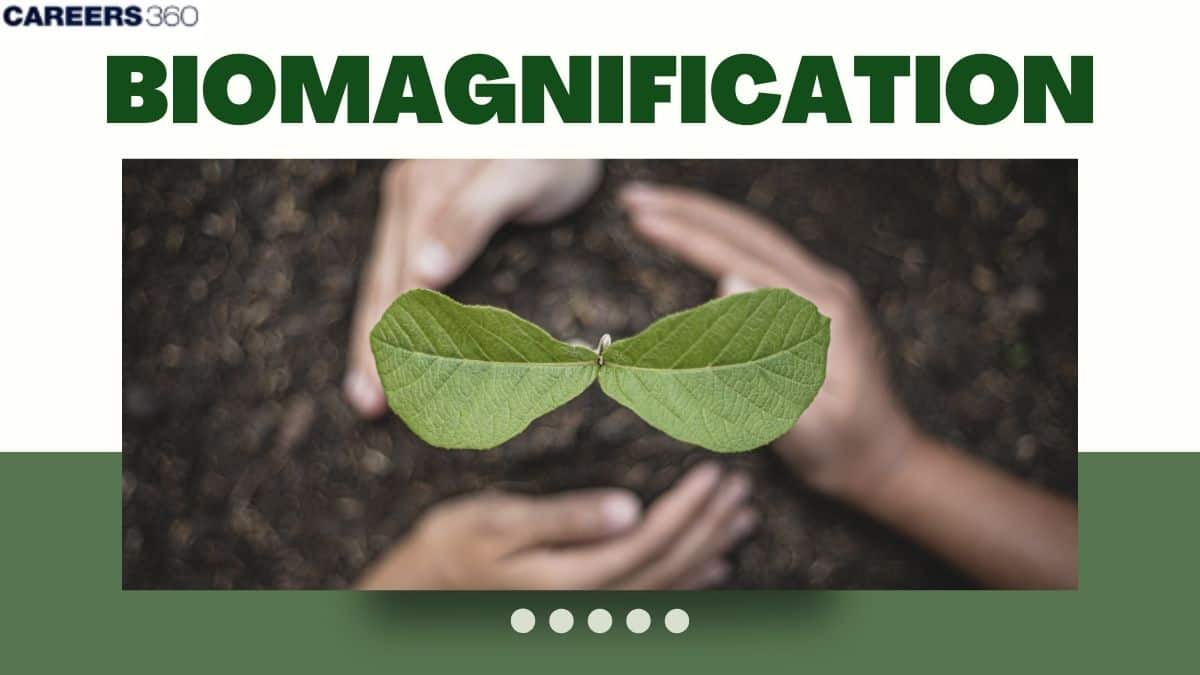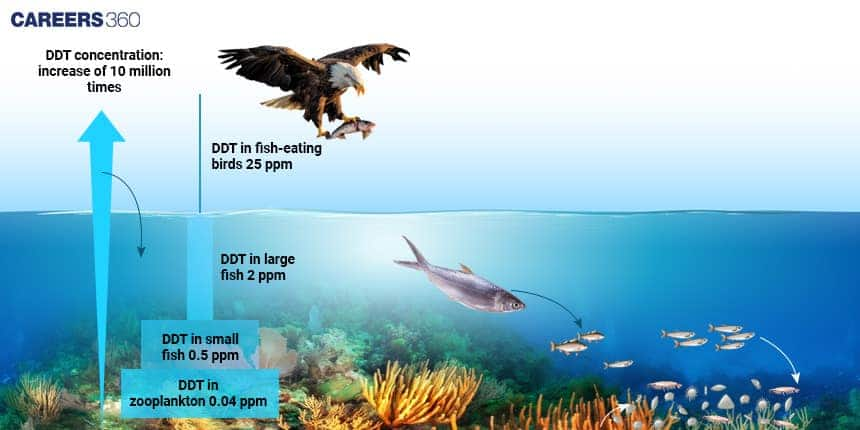Biomagnification: Meaning, Example, Causes, Effects, Topics
Biological magnification or biomagnification is the accumulation of harmful chemical substances, pesticides or heavy metals, to higher trophic levels of a food chain. Such toxins become more concentrated in their amount as they pass up the food chain and result in threats of severe health conditions to the top predators, including humans. This accumulation can occur as a result of persistence of substance where it cannot be broken down.
This Story also Contains
- What is Biomagnification?
- Causes of Biomagnification Causes
- Process of Biomagnification in Food Chains
- Pollutants Causing Biomagnification
- Effects of Biomagnification
- Examples of Biomagnification
- Biomagnification NEET MCQs
- FAQs of Biomagnification
- Recommended Video on Biomagnification

Biomagnification is the process by which harmful substances like pesticides and heavy metals accumulate in higher concentrations at each trophic level of a food chain. Examples include DDT in birds and mercury in fish. This environmental issue poses severe risks to ecosystems, wildlife, and humans. This article includes causes, process, effects, and examples of biomagnification.
What is Biomagnification?
Biomagnification is the accumulation of harmful substances, pesticides, and heavy metals at every step in the food chain. Such pollutants cannot be decomposed and therefore accumulate within an organism's tissues. The toxins are accumulated by small organisms, and then through a food chain if a larger animal feeds on them, their concentration will increase the toxin levels within the top predators. This results in serious health and environmental problems.
Causes of Biomagnification Causes
The major factors contributing to biomagnification are human activities that release persistent pollutants into the environment. Some of these pollutants include:
Pesticides: Pesticides that farmers use in large quantities, such as DDT, can greatly enhance yields but might also run off to streams and be taken up by aquatic organisms. Most of these chemicals are generally resistant to degradation and tend to accumulate in food chains.
Heavy Metals: Heavy metals such as mercury and lead are also emitted into the environment through industrial processes, mining, and dump waste. These metals are very toxic and once released into the atmosphere can stay for a long time. On ingestion, they get absorbed and stored in the tissues of the organisms, which
Industrial Chemicals: By-products such as polychlorinated biphenyls and other POPs are released from manufacturing and other related industries. They are hydrophobic, therefore they tend to accumulate in the fatty tissues of living organisms.
Agricultural runoff: This generally occurs due to fertilizers and other chemicals used during agriculture that leach into rivers and lakes, thus contaminating aquatic ecosystems. The absorbed pollutants proceed upwards from the first level of energy throughput.
Improper Waste Disposal: Chemicals at dumped sites and untreated waste materials contaminate the environment, putting into food chains a wide range of hazardous substances responsible for biomagnification.
Process of Biomagnification in Food Chains
Biomagnification is a process wherein there is downward transmission and eventual concentration of pollutants in the food chains and webs, resulting in large ecological and health impacts.
An ecosystem consists of various trophic levels. The base includes producers (plants), followed by primary consumers (herbivores), then secondary consumers (carnivores), and finally tertiary consumers, which are the top predators. All these steps offer a ladder for energy and nutritional flow in the food chain.
Steps of Biomagnification:
Various sources link pollutants entering the ecosystem through water, soil, and air.
These are then absorbed by organisms at the lower trophic levels, for example, plankton and small fish.
Since these organisms are consumed, it progresses to increasing the concentration of pollutants as they go up the food chain.
The top predators have the highest concentrations and, therefore, suffer the most devastating effects of biomagnification.
Pollutants Causing Biomagnification
Some of the pollutants responsible for biological magnification are mainly from human activities and industrial processes.
Common pollutants includes:
Pesticides: The best-known example is DDT, which was largely used to eradicate mosquitoes from communities but was later discovered to be a harmful chemical to the environment.

Heavy Metals: Mercury and lead are two metals that accumulate in the environment and pose significant health threats.
Industrial Chemicals: PCBs are utilised in electromechanical devices apart from other industrial applications but have recently been identified as highly toxic environmental pollutants.
Sources of pollutants are:
Agricultural use of chemical fertilizers and pesticides is washed into the water leading to the pollution of aquatic habitats.
Factories and industrial plants largely release untreated or poorly treated wastes into the environment.
This leads to pollutants entering the soil and water due to the dumping of hazardous wastes without treating them.
Effects of Biomagnification
Biomagnification affects wildlife, human health, and total ecological balance.
Effects on Wildlife
The classic example is the thinning of eggshells of birds owing to the DDT content. Due to this, the bird population declined since the eggs were too fragile to withstand.
Effect on Human
High levels of mercury neurologically damage an organism, while PCBs are known to be associated with cancer and other serious health effects. Long-term exposure to these kinds of biomagnified pollutants can result in serious health problems, such as developmental and reproductive impairment.
Ecological Effects
Population declines in top predators caused by toxic levels can further upset the balance in ecosystems.
Toxic pollutants can have stressful effects on sensitive species, provoking their decline or even extinction and reducing the general biodiversity.
Examples of Biomagnification
The accumulation of hazardous substances in aquatic species' vital organs interferes with reproduction and development. Sea bird eggs, for instance, have fragile shells that the birds themselves could destroy during incubation. Toxic chemicals, mercury, and selenium kill the reproductive organs of aquatic animals.
The primary factor destroying coral reefs is the use of cyanide in fishing and gold leaching. Numerous marine organisms live on and feed on coral reefs. Their destruction affects the lives of many aquatic animals.
The chemicals and toxins released into the water bodies disrupt the food chain. The tiny organisms absorb the toxins that larger animals eat up. These toxins, thus, accumulate in the higher level of organisms.
Biomagnification NEET MCQs
Q1. Which of the following exhibits biomagnification?
SO2
Mercury
DDT
Both b & c
Correct answer: 4) Both b & c
Explanation:
Biomagnification is the process that helps increase the concentration of certain chemicals such as mercury and DDT in the tissues of organisms as they move up the food web. It is one of the critical factors that threaten wildlife and human health because the toxic substances become more concentrated in predators than in their prey. Understanding biomagnification is, therefore, important to both environmental conservation and public health.
Hence the correct answer is Option (4) Both b & c
Q2. The expanded form of DDT is:
dichloro diphenyl trichloroethane
dichloro diethyl trichloroethane
dichloro dipyridyl trichloroethane
dichloro diphenyl tetrachloroacetate
Correct answer: 1) dichloro diphenyl trichloroethane
Explanation:
The expanded version of DDT is Dichloro-Diphenyl-Trichloro-Ethane.
DDT, a man-made pesticide, gained extensive use in the mid-20th century. Its primary purposes were agricultural pest management and controlling mosquitoes that spread malaria. Over time, it faced widespread bans or restrictions in various nations due to significant ecological concerns. These concerns stemmed from DDT's environmental persistence, its tendency to accumulate in food chains, and the detrimental effects it had on wildlife, notably birds.
Hence, the correct answer is option 1) dichloro diphenyl trichloroethane.
Q3. Increased concentration of DDT in fish-eating birds is due to
Eutrophication
Biomagnification
Cultural eutrophication
Accelerated eutrophication
Correct answer: 2) Biomagnification
Explanation:
Dichlorodiphenyltrichloroethane, commonly called DDT, is a tasteless, colorless, and almost odorless crystalline chemical compound.
In the aquatic ecosystem, the aquatic organisms absorb DDT and its metabolites and DDT gets adsorb on the suspended particles leaving behind little DDT dissolved in water. It occurs due to its hydrophobic properties. It bio-accumulates especially in predatory birds due to its lipophilic properties. It has the potential to kill beneficial and harmless insects, particularly pollinators, fish, birds, and eventually humans. It is an endocrine disruptor that acts as a weak androgen receptor antagonist (not as estrogen) and is considered a possible human carcinogen.
When a particular substance accumulates in the body of an organism at distinct trophic levels of the food chain, it is known as Bio-magnification. The DDT accumulates in the zooplankton which are then consumed by the fishes and eventually by fish-eating birds.
Therefore, the correct answer is option 2) bio-magnification.
Also Read:
FAQs of Biomagnification
What is biomagnification?
Biomagnification refers to an increase in the concentration of the toxicant at successive trophic levels. This happens because a toxic substance accumulated by an organism cannot be metabolised or excreted, and is thus passed on to the next higher trophic level.
What causes biomagnification?
It occurs when toxic pollutants are persistent, non-biodegradable, and fat-soluble. Since they cannot be broken down or excreted easily, these chemicals accumulate in organisms’ tissues and get passed on to higher trophic levels. Two common groups that are known to biomagnify are chlorinated hydrocarbons, also known as organochlorines, and inorganic compounds.
What are the effects of biomagnification?
It causes health issues in animals and humans, such as reproductive failure, neurological damage, and cancer.
Top predators (e.g., birds of prey, humans, marine mammals) are most affected because they accumulate the highest toxin levels.
It disrupts ecosystem balance by reducing species diversity and survival rates.
Which pollutants are responsible for biomagnification?
Pesticides: DDT, aldrin, dieldrin.
Heavy metals: Mercury, lead, cadmium.
Industrial chemicals: PCBs (polychlorinated biphenyls).
Other toxins: Arsenic compounds.
Recommended Video on Biomagnification
Frequently Asked Questions (FAQs)
Although it is pretty difficult to reverse biomagnification completely, reducing the amount of pollutant emissions and decontaminating stations can help lessen its effect.
Bioaccumulation occurs within an organism over time, while biomagnification describes the increase in toxin concentration as they are transferred up a food chain.
Some common pollutants include pesticides like DDT, heavy metals like mercury and lead, and industrial chemicals like PCBs
No, biomagnification is not good.Because biomagnification concentrates mercury higher up the food chain, seabirds that consume more clams than fish will be exposed to lower levels of toxins and have a better chance of survival.
Biomagnification harms the food chain, coral reefs, and the health of oceanic creatures and humans.
Two common groups that are known to biomagnify are chlorinated hydrocarbons, also known as organochlorines, and inorganic compounds.
Industries and factories release toxic substances into the soil, lakes, oceans, and rivers, all of which can cause biomagnification.
Questions related to
On Question asked by student community
Correct Answer: Toxic matters are magnified
Solution : The correct answer is Toxic matters are magnified.
Biomagnification is the process in which toxic matter passes through various trophic levels and their concentration levels rise with each trophic level. For bio-magnification toxins should be fat-soluble and should be a stable compound which is not easily dissociated. Examples- DDT, pesticide, mercury etc.